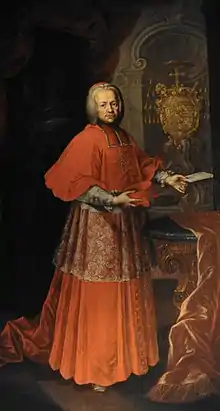Sigismund von Schrattenbach
Sigismund Graf von Schrattenbach (28 February 1698 – 16 December 1771) was Prince-Archbishop of Salzburg from 1753 to 1771.
Sigismund von Schrattenbach | |
|---|---|
| Prince-Archbishop of Salzburg | |
 Portrait by Franz Xaver König | |
| Church | Roman Catholic Church |
| Archdiocese | Salzburg |
| See | Cathedral of Saints Rupert and Vergilius |
| Installed | 26 September 1753 |
| Term ended | 16 December 1771 |
| Predecessor | Andreas Jakob von Dietrichstein |
| Successor | Hieronymus von Colloredo |
| Personal details | |
| Born | 28 February 1698 Graz, Styria, Holy Roman Empire |
| Died | 16 December 1771 (aged 73) Salzburg, Archbishopric of Salzburg, Holy Roman Empire |
| Nationality | Austrian |
Life
He was born in Graz, Styria, the son of Count Otto Heinrich von Schrattenbach and Maria Theresa, Countess of Wildenstein and widowed Baroness Gall von Gallenstein. After studying theology in Rome, Schrattenbach was ordained a priest in 1723 and obtained a seat in the Salzburg cathedral chapter in 1733. In 1747 he was appointed administrator of Hohenwerfen Castle, later also cathedral dean and privy councillor.
He was elected Archbishop of Salzburg after the death of Count Andreas Jakob von Dietrichstein in 1753, after numerous rounds of voting he finally prevailed against rivalling Joseph Maria von Thun, Bishop of Gurk. During his tenure Leopold Mozart as well as his son Wolfgang Amadeus were appointed members of the episcopal court orchestra. In 1763 he employed Michael Haydn as court composer.
Schrattenbach died in Salzburg, aged 73. His funeral service on 2 January 1772 was the occasion for the first performance of Michael Haydn's Requiem Missa pro defunctis Archespiscopo[1] written in his honour. Schrattenbach was succeeded by Count Hieronymus von Colloredo, the last Salzburg prince-archbishop before the 1803 secularisation. Michael Haydn stayed in Salzburg under the reign of Colloredo; Wolfgang Amadeus Mozart, on the other hand, left soon after.
Notes
- MusicAndHistory.com:1772 Archived 2013-03-12 at the Wayback Machine Accessed 12 March 2013
References
- Alessandro Cont, Leopoldo Ernesto Firmian (1708-1783) e l'arcidiocesi di Salisburgo, “Annali dell’Istituto storico italo-germanico in Trento”, 32 (2006), pp. 71–126.
External links
| Wikimedia Commons has media related to Sigismund Christoph von Schrattenbach. |
- Siegmund Christoph, Graf von Schrattenbach (in German)